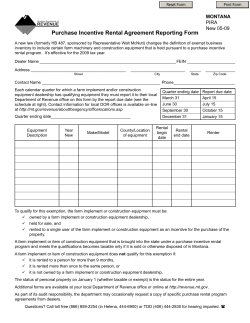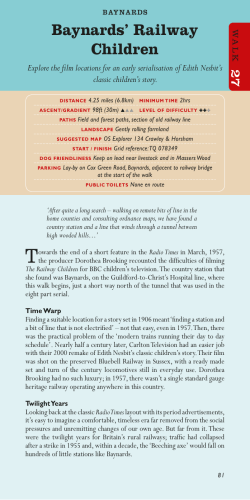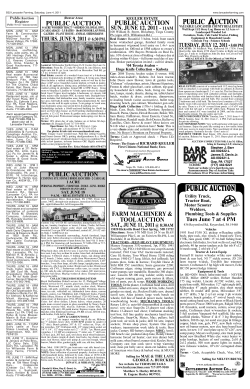
Decision Guide for First-time (or Smarter) Tractor Buying WHY
Decision Guide for First-time (or Smarter) Tractor Buying – for Farmers Growing Food for Market on Small to Medium-sized Farms Start by asking WHY you need a tractor. A tractor will require time and money so use a tractor only if it is essential to the farm operation in terms of labor and profitability. Saved labor can result in production efficiency, more time to allocate elsewhere, and improved or protected physical wellbeing. Saved time can help you avoid crop loss and harvest delay, and enable you to be more productive with limited time. Help yourself buy a tractor that will meet your needs by imagining what you will actually do with your tractor. Cut – Dig – Rake – Bale – Till – Pull – Move – Mow – Throw Plow – Dig – Shred – Haul – Lift – Disc – Drag – Shape Beds Plant – Give Hay Rides – or? Develop a job list of physically demanding or time consuming chores that you want a tractor to perform. Better yet, make two lists: (1) jobs I will definitely do with a tractor and (2) jobs I might do with a tractor. Add a note about how frequently you expect to perform each job per year. To help you think about this, look ahead in this Guide to the section Farm implements you want your tractor to power. Specify on how many acres you will actually use a tractor, both now but also possibly in the future. Example: You have a 50-acre farm, with 3 acres in production, and another 3 acres you may put in production. You also work in your woods and would use the tractor for most jobs. This adds 5 acres. So, at most, you will use a tractor on 11 of your 50 acres. Estimate a field (or farm) efficiency measurement for a tractor. What percent of time that you spend doing work in your field or on your farm do you imagine actually performing work that requires a tractor? Does this amount of time seem worth the investment you are considering? Example 1: You work alone and are in your field 40 hours a week for 5 months, or a total of 860 hours. Reviewing the job list you developed, you imagine you will use a tractor almost 260 hours, or 30 percent of the time. Example 2: Two people each work in your field 20 hours a week for 5 months, and also you work alone on other projects around the farm about 10 hours a week for 7 months, for a total of 1,161 hours. After reviewing the job list and confirming that both of you will use the tractor, you imagine the tractor will be used about 700 hours, or 60 percent of the time. Lessons Learned, Central Ohio Food Farmer, Mary Bridgman, Bridgman Farm: I wasted thousands of dollars twice buying equipment that was too small for what I was doing. I was so intimidated by the cost of tractors that I tried to scrimp and, in the end, it cost me more. Gain or Review Your Basic Knowledge of Field Tractors. Transmission Type Options There are many transmission types and combinations, and newer ones are introduced regularly. Three key concepts are presented. Standard Transmission (or Manual or “stick shift”) Step on clutch and shift gears Least expensive Hydraulic Automatic Transmission Uses a fluid coupling (torque converter) that takes the place of a mechanical clutch, allowing the transmission to stay in gear and the engine to remain running while the vehicle is stationary, without stalling. One type of two clutches is used for routine upshifts/ downshifts. Predominant form of automatic transmission, typical on larger tractors but can be an option on compact models Hydrostatic Transmission (Hydro) – a type of Continuously Variable Transmission (CVT)* Simply move a hand lever or push a foot pedal; no need to use a clutch to shift gears, better fuel economy by enabling the engine to run at its most efficient RPMs for a range of speeds Greater cost; low maintenance but possibly higher maintenance costs due to complex hydraulic drive system Compiled by Women Farm, for reference use only (www.womenfarm.com), 3/6/2013 Page 2 of 12 Standard Transmission (or Manual or “stick shift”) Good choice if most work is operating a shredder or pulling a plow Hydraulic Automatic Transmission Requires automatic transmission fluid (ATF) primarily made from refined petroleum that needs routine service as vehicle ages May have High & Low ranges providing up to 8 forward speeds Hydrostatic Transmission (Hydro) – a type of Continuously Variable Transmission (CVT)* Less likely to become stuck, as operator can continue to move forward or backward when adjusting to traction conditions Holds up well over life of a tractor * CVT is an automatic transmission that is fundamentally different from the hydraulic automatic transmission Tractor Engine Options Most tractor engines are powered by one of two types of fuel. Gasoline Engines Readily available to the engine so the tractor may start better in cold weather and have greater responsiveness More trouble mechanically, moisture and long periods of idleness cause carburetor problems and can lead to starting difficulties Diesel Engines More powerful, more work per gallon; less affected by wetness and idleness; less volatile than gasoline so safer to store and to drive into buildings Can have starting problems during freezing conditions so may need to use an engine warmer; if engine runs out of fuel, air has to be pumped out of the system before fuel injectors will work (requires a service call) One of the advantages of a tractor over a team of horses or other animals is that an engine can transmit power to an implement, which it does through the PTO. However, horse-drawn implements and opportunity to use draft horses is an option. Tractor engines that use alternative fuels are in design and entering the market. A hydrogen fuel cell tractor that runs on hydrogen created by use of wind, solar or biomass (from plants such as corn and sugar cane) was showcased by New Holland Agriculture in 2011. Converting to natural gas, electric, and batteryoperated engines is also occurring. Compiled by Women Farm, for reference use only (www.womenfarm.com), 3/6/2013 Page 3 of 12 Wheel Drive Options Two-Wheel (2WD) Used in dry or upland not wet, hilly and muddy conditions Smaller turning circle, simple design, fewer mechanical parts, lower purchase price 5 – 200 HP Front Wheel Assist (FWA) Commonly known as 4WD or Unequal 4-wheel Drive Most popular 4WD; front drive tires smaller than rear tires Delivers more power to the ground for same fuel consumption, has much better traction than samesize 2-wheel tractors 5 – 240 HP Equal Four-Wheel (4WD) Challenging to maneuver; all tires of equal size Greater power to weight ratio, expanse may make it impractical 35 – 600 HP Excerpt from What Size Farm Tractor Do I Need? University of Georgia Wisdom Shared, Central Ohio Food Farmer, Val Jorgensen, Jorgensen Farms: I would not buy a tractor without 4 wheel drive. You only use it when you need it but when you need it, you need it! Horsepower (hp) Horsepower is the common method for communicating tractor size. Basically, horsepower measures the tractor’s ability to move a load. By definition one horsepower is the amount of energy required to move 33,000 pounds a distance of one foot in a time span of one minute. Tractor salespersons may describe a tractor by an older method of drawbar (or draft) horsepower, or they may use the newer and more common method of PTO horsepower. On average for most tractors, the drawbar horsepower is 85 percent of the maximum PTO horsepower. Be sure you know which type of horsepower the salesperson is talking about. Brake horsepower is yet another term that may be used, especially when talking about stationary engines. This is the maximum power the engine can delivery without alterations. Because you want to match the tractor to the jobs it will be performing, many variables should be considered and discussed as you define your horsepower requirement. Soil type and conditions, topography, the width of implements that will be pulled, time allotted for a job, life or bucket capacity, the size on width or amount and condition of material input an implement is expected to process, need for simultaneous operations, and integral tractor equipment such as hydraulic systems and air conditioning. Compiled by Women Farm, for reference use only (www.womenfarm.com), 3/6/2013 Page 4 of 12 Higher working speeds require more horsepower. You may want to define your preferred performance rate (acres per hour) when defining your horsepower requirement. Wisdom Shared, Central Ohio Food Farmer, Val Jorgensen, Jorgensen Farms: My 85 hp Kubota has a front end loader for lifting pallets, round bales of hay, and a bucket for turning compost and performing other farm tasks. I also use it for all tillage work (plow, disc, drag). My 35 hp Kubota is used for mowing, bed shaping, giving hay rides, and planting. My tillage requires the most horsepower and finishing work and planting less horsepower. Tractor weight, which is often used as a selling point, has little bearing on a tractor’s capacity to perform work. Beware of the fact that lift capacity of a loader or 3-point hitch can be measured in several ways: lift capacity to full height, static lift capacity, pivot pin capacity, bucket center capacity, lift arm capacity, 24 inches aft of lift arm capacity. Be clear what measure is being discussed. Also, a front loader that can lift a lot of weight may have a very slow cycle time. Lift capacity may be a useless measure when comparing tractors. It may be more important to buy a loader that is produced by the same manufacturer as the tractor that is performance matched to the particular model of the tractor you buy. Tractor Hitch Options Farm implements that you will attach to your tractor require a hitch, and farmers use a three-point hitch more frequently than any other variety and accepted as the industry standard by the American Society of Agricultural Engineers. A 3-point hitch provides a quick hook up to a variety of implements regardless of manufacturer. This type of hitch has two lower arms that run on hydraulic cylinders and can raise and lower the hitch, and one fixed arm which provides a rigid connection. It can connect to the front and back end of tractors. There are four categories of 3-point hitches most relevant to you, amazingly labeled one way, but more commonly referred to another way as noted in parenthesis! Category 0 (cat. 1) For tractors up to 20 hp Category 1 (cat. 2) For tractors 20 – 45 hp Category 2 (cat.3) For tractors 55 – 95 hp Category 3 (cat.4) For tractors above 95 hp A drawbar hitch is often used for simple pulling, such as a disk or wagon. One portion of a U-shaped arm fits over top and another portion fits underneath a plate on the back of an implement and a sturdy pin goes vertically through holes in all layers. Drawbars are not affected by the Category of a 3-point hitch. Compiled by Women Farm, for reference use only (www.womenfarm.com), 3/6/2013 Page 5 of 12 Power Take-Off (PTO) Systems The Power Take-Off is a mechanical feature, a drive shaft, that takes some of the power that the tractor’s engine creates and uses it to run implements and tools that you attach to the tractor. The PTO holds, lifts, and lowers the implements, typically connecting implements drawn behind the tractor. With special installations the PTO can connect belly- or mid-mounted or also front-mounted equipment. The PTO is a very dangerous feature on a tractor, spinning on most tractors at 540 RPMs (revolutions per minute) and capable of wrapping clothing around it nine times in just a second. See Safety Features and Tractor Buying, a following section in this Guide. Transmission Driven PTO Driven directly off a gear in the transmission; PTO is either fully off or fully on; clutch must be completely depressed to bring all rotation of the transmission to a stop before engaging the PTO on position Simple design; low cost and less maintenance Unable to fully control tractor direction and speeds without disrupting implement power Live PTO Best known as a dual clutch arrangement, one of which engages/disengages the tractor’s transmission and one that engages/ disengages the PTO; if tractor has a hydrostatic transmission, tractor speed and direction can vary while PTO output remains constant Relatively simple design; operator friendly More expensive to repair; more leg muscle required Mechanical Independent PTO Hydraulic Independent PTO Like a dual clutch live PTO except has two PTO controls – hand lever to control the engage/release of the PTO clutch and another level that couples/uncouples the PTO shaft in the drive train Move only a single lever or push a button to start/stop the PTO shaft. Can select on and off independent of tractor travel and speed Can engage the PTO clutch slowly, more controlled manner, while the tractor is on the go Have to use two control levers Most user friendly; maximum flexibility in determining on and off of PTO Most expensive and complex; higher cost; higher maintenance Older tractors may have a pulley on the side to operate a belt to a stationary machine, such as a feed grinder. Compiled by Women Farm, for reference use only (www.womenfarm.com), 3/6/2013 Page 6 of 12 Farm Implements You Want Your Tractor to Power It is important to identify what type of farm implements you expect to use in conjunction with a tractor, before you buy the tractor. The tractor that will best power the implements you plan to use helps define requirements for the size, power, source, and capacity of your tractor. Review the following list of select implements that may be used by a small- to medium-sized farm that grows food for regional markets. Select List of Implements Backhoe Bed shaper Chain harrow (drag) Chisel plow Disk harrow Field cultivator Front-end loader Grain drill Hammer knife mower Manure spreader Moldboard plow Mower-conditioner (haybine) Post-driver Posthole digger (auger) Rake Rotary mower Row crop cultivator Row crop planter Scraper blade Sickle bar mower Utility trailer Wagon √ = Plan to use It is important to right-size your tractor, which allows you to get the work completed on time at the lowest possible cost. A tractor that is too small for your operation can result in long hours in the field, excessive delays, and premature replacement. A tractor that is too large for your operation can result in excessive operating and overhead costs. A small vegetable farm may need a tractor with as little as 25 – 30 hp and a grain farm may need 100 hp. Compiled by Women Farm, for reference use only (www.womenfarm.com), 3/6/2013 Page 7 of 12 Lessons Learned, Central Ohio Small Grains Food Farmer, Maryann Burr, Burr Farm: Initially I bought 85 hp and then needed implements that required more umph. I kept incrementally buying bigger and stronger and still could benefit from more hp. I am quite fond of my used John Deere 4955 with 190 hp! Tractor Safety Features Agriculture is the most hazardous industry in the United States. The tractor is the most-used machine on most farms and tractors are involved in more fatal injuries than any other agent of injury. The leading cause of death on the farm is the tractor rollover, or overturn. Farmers are at very high risk for fatal and nonfatal injuries. When purchasing a tractor consider several important safety features. A tractor model commonly known as “tricycle” model, typical on older tractors, have two front wheels that are close together. This model tips more easily and is harder to steer on rough ground. All tractors should be equipped with a Roll Over Protective Structure (ROPS). ROPS is designed to guard the operator from being crushed in the event of a turnover and is safety tested and labels by OSHA standards. It is only effective when using a seatbelt. Not all tractor cabs are ROPS cabs. ROPS are 99 percent effective in preventing rollover deaths and serious injuries. Most newer tractors come equipped with a factory installed ROPS. Older tractors may not have one or have an improper ROPS. To be effective ROPS need to be properly designed, manufactured, and installed. Talk to your manufacturer or local farm equipment dealer about the availability of ROPS retrofit kits. If they are available, the tractor should be retrofitted. Kentucky publishes a ROPS Guide organized by tractor make and model at http://warehouse.ca.uky.edu/rops/indexoriginal.asp. If kits are not available, the tractor should not be operated. For more information see http://ohioline.osu.edu/aexfact/192/pdf/0192_1_56.pdf If you buy a tractor, when operating and maintaining it avoid the types of negligence that result in the majority of machinery-related accidents: taking shortcuts to save time; failure to read operator’s manual; ignoring warning signals; improper or lack of instruction or training; failure to follow safety rules; and improper or lack of maintenance. Compiled by Women Farm, for reference use only (www.womenfarm.com), 3/6/2013 Page 8 of 12 Review Available Tractor Brands and Models. Once you have defined your needs and preferences for a tractor you may want to get more familiar with actual tractors before you start shopping. Familiarize yourself with manufacturers and tractor models. Attend farm trade shows or fairs with equipment displays. Visit neighboring farms or go on farm tours. Specifically ask about the tractors and the praise and complaints the farmer has of the tractor. Also get recommendations from experienced farmers on tractor dealerships. Review websites such as those listed below. Eleven web sites to use to become more familiar with manufacturers (brands) and tractor models, listed in alphabetical order. www.auctionbill.com www.auctionzip.com www.equpmenttraderonline.com www.farmanddairy.com www.farmworldonline.com www.fastline.com www.higginsauctions.com www.jdequipment.com www.midwestauction.com www.tractorhouse.com www.trigreeneq.com www.usfarmer.com To Buy or Not to Buy? The cost to your farm operation is not just the purchase price. It may include financing the purchase (interest). It will definitely include regular maintenance; occasional repairs (per acre; annually every spring and fall; or every 100 hours); and housing and insurance. You may think that some cost will be offset by tax benefits such as an IRS depreciation deduction or a state sales tax exemption. Both the federal and state government has strict regulations that should be reviewed to challenge or confirm your assumptions. Such information may affect if or when you buy a tractor. Compiled by Women Farm, for reference use only (www.womenfarm.com), 3/6/2013 Page 9 of 12 While newer tractors cost more they likely will have lower repair costs. Generally, the higher the price of a new tractor the higher the repair costs. Lessons Learned, Central Ohio Food Farmer, Mary Bridgman, Bridgman Farm: Twelve years ago I purchased a 3-year old John Deere for $22,000. Just one year ago I had my first repair issue – a new starter. It has done everything I’ve asked of it and more. When considering a used tractor, know that the age of a tractor is measured in hours of use, not years. Every tractor should have a functioning engine hour meter. The life of some tractors could be 8,000 hours. Find out from the manufacturer what the expected life is for any model you are considering. Also, beware of painted used tractors as paint can be used to hide many different problems. Farm Industry News published a tractor inspector’s suggestions in “9 tips for buying used” which you can review at http://farmindustrynews.com/9tips-buying-used. Photos can help you understand what to look for, offered on an Australian advice web site for small farmers, http://farmstyle.com.au/news/whatlook-when-buying-used-tractor. Whether buying new or used, if you think you may sell the tractor in the future, a name brand will likely have higher resale value. Advice Offered, Central Ohio Small Grains Food Farmer, Maryann Burr, Burr Farms: Drive several tractors before you buy! Try turning in tight spaces. Use reverse. Each brand makes turns and steers differently. If the tractor is used, you will get a feel for how the owner treated the tractor. In addition to using the web sites listed earlier to gain information about the cost of tractors, you can also check out tractor values using official guides, such as: www.tractorbluebook.com www.ironguides.com/digitalAppraiser.aspx Most typically, you would purchase a tractor from a farm equipment dealer or from individuals. Both dealers and individuals might sell through live and on-line auctions, and run classified advertisements in local or regional newspapers, farming publications, or on the web. No matter which source, be sure to consider the distance between you and the current location and to understand, if needed, what trucking firm is willing to custom haul at a reasonable rate. Look for Ohio farming equipment dealers, both new and used equipment dealers at: http://www.ohioagriculture4u.com/ohio_farming_equipment_dealers.htm Compiled by Women Farm, for reference use only (www.womenfarm.com), 3/6/2013 Page 10 of 12 There are some advantages of working with an established farm equipment dealer, especially if you are new to tractors. A dealership may provide service trucks that travel to your farm for routine maintenance and/or they may offer a service center and be willing to pick up and deliver your tractor for a fee. Dealers may offer tractor training in machine operations and safety. If buying a new tractor, the dealer will offer a solid warranty and maintenance contract. If buying a refurbished tractor, the dealer may offer a limited warranty and perhaps a limited service contract. Do you really need to purchase a tractor? If the work you expect a tractor to perform is done infrequently (1 day or week) or periodically (1 season), you may be better off financially by not buying a tractor. Rent or lease a tractor from a local dealer, after checking on their policies and being assured they stand by their equipment’s proper operation and that they will address breakdowns in a timely manner. Costs may be by the hour or day and you will have no maintenance or repair costs. Hire a local farmer or commercial operator and benefit from the use of their skills and equipment. Costs may be by the hour or day or job and you will have no maintenance or repair costs. Exchange with a neighboring farmer. Use their equipment for something you offer (services or other equipment) of equal value to them. Form a cooperative with neighboring farmers, through which you share ownership of the equipment that all use and benefit from. Be sure to have signed, written agreements about how costs and usage will be shared: purchase costs, repairs and maintenance. Work done on small acreage or a parcel could be performed by your own powerful walking behind a rototiller that has multiple attachments. Women Farm will periodically update and revise this Guide, and welcomes input from women farmers, farm educators, farm equipment dealers, and other interested parties who seek to expand and improve the quality of information and decision making tools available to current and aspiring food farmers. Compiled by Women Farm, for reference use only (www.womenfarm.com), 3/6/2013 Page 11 of 12 Primary Sources of Reviewed Content American Small Farm, Farm Machinery & Equipment Safety, Marjorie R. Margentino and Karyn Laminowski, February 2007. American Society of Agricultural Engineers, Terminology and Definitions for Agricultural Tillage Implements, ftp://ftpfc.sc.egov.usda.gov/MT/www/technical/agronomy/TerminologyandDefiniti onsforAgriculturalTillageImplementsMarch2009.pdf Ewald-Kubota, Tractor Buying Facts, http://www.ewaldtractor.com/wiki/EWI/TractorBuyingFacts Johnson City Kubota, Power Take Off School, http://www.johnsoncitykubota.com/Power%20Take%20Off%20Types.htm Ohio State University, Machinery Costs Computer Program http://aede.osu.edu/sites/drupal-aede.web/files/MachCosts.pdf OK Tractor, 3-point hitch specifications and definitions, http://www.oktractor.com/3point.htm Rodale Institute, Your First Tractor, Part I and II http://newfarm.rodaleinstitute.org/columns/gd_tractor/2005/0421/index.shtml http://newfarm.rodaleinstitute.org/columns/gd_tractor/2005/0602/index.shtml EQUUS, Tractor Talk: A Rookie’s Guide to Buying a Tractor, Joanne Meszoly http://www.discoverhorses.com/all-about-horses/tractor-talk-a-rookies-guide-tobuying-a-tractor/ University of Georgia, What Size Farm Tractor Do I Need? http://www.caes.uga.edu/departments/bae/extension/pubs/documents/farm%20t ractor.pdf Wikipedia, Automatic transmission, http://en.wikipedia.org/wiki/Automatic_transmission and and Continuously variable transmission http://en.wikipedia.org/wiki/Continuously_variable_transmission wiseGeek, What Is a Hyrdostatic Tractor? http://www.wisegeek.com/what-is-ahydrostatic-tractor.htm and Should I Buy a New or Used Tractor? http://www.wisegeek.com/should-i-buy-a-new-tractor-or-a-used-one.htm Compiled by Women Farm, for reference use only (www.womenfarm.com), 3/6/2013 Page 12 of 12
© Copyright 2026











